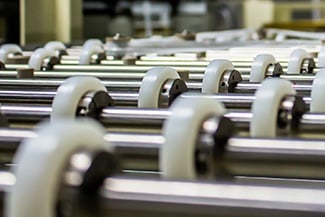Do you have a CFO breathing down your neck to reduce manufacturing inventory costs? As the VP of Manufacturing, you have one tough job!
On one hand, if you don’t have enough of the right inventory on hand when it’s needed, you risk damaging customer relationships. Your customers are counting on you to have the correct solutions by having what they need on hand when they want it. In a worst-case scenario, low inventory levels can cripple your business. Without product to ship, you won’t have revenue coming in. Without a good reputation for delivering on your promises, customers begin to disappear.
On the other hand, you don’t want to be carrying too much inventory either. Too much inventory brings the risks of obsolescence, damage, and additional storage/carrying costs. The problem is compounded for many US-based companies in the Manufacturing industry because it is commonplace to now outsource most high-volume manufacturing overseas to China, Mexico and other countries with lower-cost manufacturing. That means, the inventory that you have on hand is all for the high-mix, low-volume work.
How do you lower inventory costs when you are charged with producing 5-10 pieces at a time instead of 1000s at a time?
Here are 5 steps we recommend regularly for our high-mix, low-volume manufacturing clients:
- Adopt a single piece flow mentality
Single piece flow eliminates waste by working on one product at a time. While not always practical (like when you have high change-over times), it is an ideal state of lean manufacturing to achieve single piece flow whenever possible. Benefits include improved quality, lower defects, less inventory holding risks and improved manufacturing flexibility.
- Find strategic suppliers
Reduce on-hand inventory by developing relationships with suppliers so you only get what you need for a given day. Working closely with your key suppliers, you can reduce the amount of safety stock you carry as buffer against missed deliveries once they have proven to deliver consistently on time. Then you can reduce the lot size on your orders. You won’t then need so much warehouse space and your manufacturing environment overall will stay more organized and become more efficient.
- Eliminate or reduce buffer inventories
When single piece flow isn’t possible, you may need to establish some buffer inventory in WIP so that your downstream processes can keep running. However, you always want to keep looking for ways to eliminate or reduce these buffer inventory stock levels. Reducing downtime, yield loss and change-over times allows you to reduce your buffer inventory. Calculate this using EPEI to get quantitative insight. If you have to use buffer stock, set up the inventory pulling process to automatically trigger the buffer stock replenishment process. “Take one, make one” is a great motto, but again, not always possible for the same reasons that single flow processes aren’t always feasible.
- Get rid of expensive equipment
If you have equipment that’s expensive to own, expensive to run and or expensive to maintain, ask yourself, “Can you get rid of it?” Look for how you might outsource that process to reduce your expenses and eliminate any manufacturing bottleneck for creating downstream or finished good inventory.
- Connect sales orders to manufacturing
When the sales order processing system and the manufacturing resource management system are disconnected, you risk running into all sorts of issues. Sales may think that materials are on-hand, but in reality they’ve been committed to another customer order. Linking Sales Orders with Manufacturing eliminates duplication of effort and makes it clear what is available-to-promise. Orders can be broken into digestible chunks for production. Inventory levels stay balanced. Contact us for more information.
Written By: Doug Bulla
Other articles you might be interested in:
{% set pop_posts = blog_popular_posts(‘default’, 3, ‘business-transformation’) %} {% for pop_post in pop_posts %}
{% endfor %}

